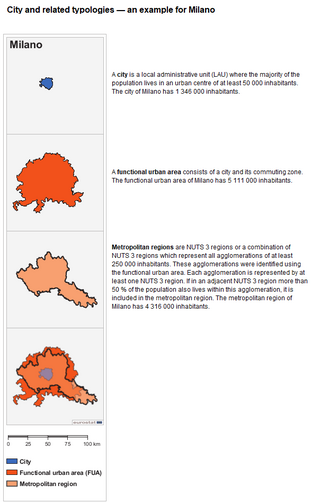Top Qs
Timeline
Chat
Perspective
Functional urban area
Measure of metropolitan and surrounding areas From Wikipedia, the free encyclopedia
Remove ads
The functional urban area (FUA), previously known as larger urban zone (LUZ),[1] is a measure of the population and expanse of metropolitan and surrounding areas which may or may not be exclusively urban.[2] It consists of a city and its commuting zone,[3] which is a contiguous area of spatial units that have at least 15% of their employed residents working in the city.[4]


The FUA represents an attempt at a harmonised definition of the metropolitan area. Eurostat's objective was to have an area from which a significant share of the residents commute into the city, a concept known as the "functional urban region."[5] To ensure a good data availability, Eurostat adjusts the FUA boundaries to administrative boundaries that approximate the functional urban area.[6]
Remove ads
History
The definition was introduced under the name Larger urban zone (LUZ) in 2004 by Eurostat, the statistical agency of the European Union (EU), in agreement with the national statistics offices in the member states.[7][8] Eurostat data is provided only for zones in the EU countries, candidate countries and EFTA countries. Several cities were excluded by definition from the 2004 list of LUZs on technical, definitional grounds, such as the coincidence of the metropolitan area with the urban zone.[9][10][11]
In 2006 LUZ definitions were changed significantly, improving the comparability of LUZ definitions across different countries, and allowing for almost all cities to be included.[citation needed]
In 2011, the European Commission has developed a new definition of LUZ in cooperation with the OECD.[12] The term Larger urban zone (LUZ) was later renamed as the Functional urban area (FUA).[1]
In 2020, the Food and Agriculture Organization, the United Nations Human Settlements Programme, the International Labour Organization, and the World Bank have also adopted the Functional urban area as their definition for delimitation of metropolitan areas.[13]
Remove ads
List of functional urban areas by population as of 2017
Summarize
Perspective
This section duplicates the scope of other articles, specifically List of metropolitan areas in Europe. (August 2025) |
This is a list of functional urban areas by population as of 2017. The 2004 Urban Audit also includes cities from EFTA countries (Iceland, Liechtenstein, Norway and Switzerland) and EU candidate countries, although the only candidate country for which there is available data is Turkey. Some cities, including Marseille, Lille, Nice, Cordoba, Badajoz, Toulon and Montpellier were excluded from the 2004 list on technical, definitional grounds, such as the coincidence of the metropolitan area with the urban zone.
List of functional urban areas
This is a list of functional urban areas. The Urban Audit also includes cities from EFTA countries (Iceland, Liechtenstein, Norway and Switzerland) and EU candidate countries. The Organisation for Economic Co-operation and Development (OECD) uses a similar definition of Functional Urban Area to represent population sizes of cities in OECD countries.[15] This data is also included.
The figures in the Eurostat database are an attempt at a compromise between harmonised data for all of the European Union, and with availability of statistical data, making comparisons more accurate.[16]
Remove ads
See also
Notes
- The Flemish Diamond metropolitan region, which consists of the metropolitan areas of Brussels, Antwerp, Gent, and Leuven, has a total population of 5,103,000.
- Part of the wider Öresund region, which includes the Swedish metropolitan area of Malmö (961,000). The total regional population is 2,842,000.
- 2014 data
- 2017 data
- Part of the polycentric Upper Silesian urban region with a total population of 5,294,000. The region additionally includes the metropolitan areas of Ostrava (1,046,000), Bielsko-Biala (584,000) and Rybnik (526,000).
- Leeds and Bradford counted separately.
- Kortrijk not included.
- Part of the wider Lille-Bassin Minier region with a total population of 3,115,000.
- 2014 data
- Part of a wider polycentric urban region with a population of 6,011,000.
- Part of a wider polycentric urban region with a population of 3,714,000.
- 2015
- Part of a wider polycentric urban region with a population of 1,778,000.
- Excludes Southampton
- 2015
- Polycentric metropolitan area
- Excludes Neuss.
- Part of the polycentric urban region of Rhein-Ruhr, which has a total population of 12,190,000.
- Excludes Bonn which has a population of 750,370
- Excludes Bonn
- Essen, Bochum, and Dortmund counted separately.
- Saarbrücken only
- Excludes Sunderland
Remove ads
References
External links
Wikiwand - on
Seamless Wikipedia browsing. On steroids.
Remove ads

